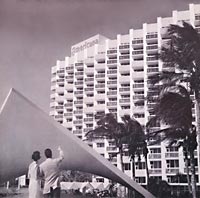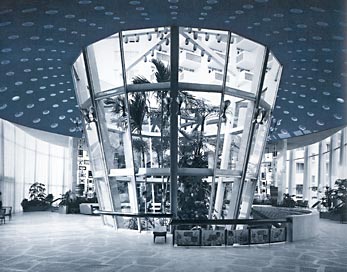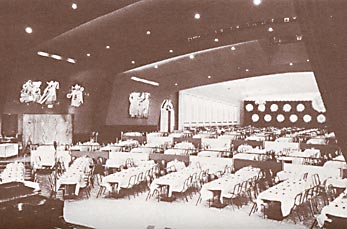
With the Sheraton Bal Harbour set to become the über-ritzy St. Regis Resort & Residences, it might be interesting to take a brief look back at the hotel’s history.
The Sheraton Bal Harbour was originally built as the Americana Hotel by Robert and Laurence Tisch of the Tisch Hotel chain, and opened on December 1st, 1956. The 475-room Americana cost $17 million to build and on its opening day commanded the unheard of rate of $32 per day. As business boomed, the hotel soon expanded to 720 rooms.
The Americana had four restaurants where the wait-staff wore uniforms ranging from waitresses in costumes reminiscent of Jeanette MacDonald’s “Rose Marie” operetta, to waiters in Argentine cowboy pants in the Gaucho Steak House. By 1968, scantily clad French show girls were performing the “Toujours Paris Revue” in the Americana’s Carioca Lounge.
The hotel was designed by famed Miami Beach architect Morris Lapidus who had just completed the Fontainebleau and Eden Roc hotels and the interior of the Sans Souci, all further down Collins Avenue in Miami Beach.

The Americana was built at a time when the sleepy village of Bal Harbour didn’t offer much in the way of excitement other than pristine beaches and one other hotel, the Kenilworth, where TV personality Arthur Godfrey broadcast his shows to America.
As usual, Lapidus was criticized by his contemporaries for various contrived transgressions, among which were that he had built “a monument to vulgarity.” It’s interesting to note, however, that while his accusers are mostly forgotten in the pages of history, the name Morris Lapidus has remained synonymous with innovative ground-breaking design for more than half a century.
In true Lapidus form, the Americana’s design included a large glass-enclosed terrarium in the center of the lobby filled with orchids and rare fungi which angled up into a ceiling filled with “cheese-holes” which Lapidus had also used so successfully in the Fontainebleau’s design. It’s said that Lapidus wanted to stock live monkeys in the terrarium, but modified his plans when owners frowned on the idea. The terrarium functioned as a miniature rain forest complete with periodic rain showers and artificial moonlight.

Here’s how the Americana described its Bal Masque Supper Club…
The BAL MASQUE SUPPER CLUB is one of Florida’s most fabulous nightclubs, daringly original, tremendous in scope! This is the setting for spectacular shows, featuring the top entertainers of the world, and leading orchestras. Six three-dimensional murals -shown on facing page depict the celebrated carnival scenes of the Americas . . . each mural authentic as to the costumes and musical instruments of the country it represents! Fashioned by famous Anton Refregier of wood veneer, and welded steel and bronze rods, these murals are detached from the walls; the figures actually float in space, and glow when the room is darkened for a show. The spectacular BAL MASQUE ROOM and the MEDALLION ROOM together, when the soundproof wall is removed, become the GRAND BALLROOM of the AMERICANA…scene of the most exciting events of the season!
The Bal Harbour Shops would be built in 1965 by the Whitman family and begin the village’s transition to a world-class shopping destination. The Americana benefited immensely from its location right across the street from the Shops, and in 1980 the hotel became the Sheraton Bal Harbour.
The Americana was the last major hotel built in the area until the Loews Miami Beach Hotel opened in 1998. On the day the Loews Miami Beach opened, the CEO of Loews Hotels was Jonathan Tisch, son of Robert Tisch who had opened the Americana 32 years earlier.
ABOUT THE ARTISTS
The effort that went into the Americana Hotel is best displayed by a look at the many artists that contributed to the hotel’s design…
MORRIS LAPIDUS of Miami and New York is among the world’s outstanding architects. Not content with working just with an exterior shell, Mr. Lapidus plans the interior decoration also to insure continuity of his original concept of the hotel, and frequently becomes artist to achieve what he has in mind. In addition to the huge stabile screen in the lobby, Mr. Lapidus designed the hotel’s carpeting and much of the furnishings.
MARIANNA VON ALLESCH was born in Bavaria, the daughter of a baroness and an officer of the Imperial Army. She defied parental wishes to devote her time to the arts and crafts, studying under European masters. Her first exhibition of blown glass in 1922 won her immediate fame. Within a few years, her glass figurines made in Thuringen became so popular that she had 6,000 glass blowers in her employ. Deflation in Europe caused her to move to America in 1928 and, from her New York studios, she turned her talents to ceramic lamps and accessories. Her work is displayed in museums throughout the country. In the Americana, Miss Von Allesch did the room and lobby lamps, and the door escutcheons.
WILLIAM BOWIE, a native of Ohio, moved to New York to seek artistic acclaim, but soon became dissatisfied with conventional artistic media. Always on the lookout for new media, Bowie’s early mosaics were constructed of leather scraps, but he soon discovered cellulose sponges in a dime store and used them to form his pattern after dyeing them various colors. One evening on his way home from work, Bowie stopped for a visit at the National Serigraph Gallery in New York. He had one of his sponge mosaics with him, and Doris Meltzer, head of the gallery, insisted on hanging it in the exhibit. So many persons were enchanted with the new art form that they placed orders, and his works have been in great demand ever since. His sponge mosaics can be found in the Americana lobby and in the Lanai suites.
HERMAN BROCKDORF was born in Copenhagen, Denmark, came to the United States in 1929, and has exhibited throughout the nation, winning numerous national awards. Two of his paintings were selected for the O.W.I. show in the National Gallery, London, and Glasgow Museum of Art. His art has found wide acceptance and he is recognized as one of Florida’s outstanding artists. The stone columns in the Americana lobby are his work.
ROBERT COOK was born in Boston in 1921, and studied sculpture there under George Demetrios. After serving in a model-making section of the army during World War II, he attended the Academie des Beaux Arts in Paris. He received grants by the Tiffany Foundation, the American Academy and National Institute of Arts and Letters as well as a Fullbright Commission. For the past five years, Mr. Cook has been working in Rome. His work has been shown often in major European and American exhibits of contemporary art. Using a fluid and open style of his own devising, Cook’s sculpture is modeled in a heavy beeswax which he molds directly with a hot soldering iron. In his hands, this results in a delicacy not available through other techniques. Others of his works are in wood, or in bronze, such as “Rodeo”, the Americana’s showpiece.
AUDREY CORWIN is a Florida artist known for her over-life-size monument portraits for the University of Miami, and for the bust of George Washington Carver in the State National Park in Diamond, Missouri. A student of the Art Institute of Chicago, Miss Corwin’s work can be found in numerous public buildings throughout Florida, and her work is in major private collections and museums throughout the nation. The miniature mountain in the terrarium was originally sculpted in model size by Miss Corwin.
ELMO GIDEON is a native of Kansas who studied at the Chicago Academy of Fine Arts. He has exhibited in major shows both here and abroad. Awards in the American Artist Professional League include: 1st prize, 1951; best over-all award, 1955; and grand national finalist, 1956. The Caribbean suite figures, and guest room oil paintings are his work.
CHARLES R. JACOBSON was born in Chicago and received his education and art training in that city. One of the nation’s non-objective painters, he has been a resident of Miami since 1944, and has spent much of his time in the Caribbean areas and Mexico, accumulating hundreds of sketches which have been adapted in many of his compositions shown throughout the nation. The copper column panels in the lobby are the work of Mr. Jacobson.
MIRA JEDWABNIK was born in Poland, and came to the United States in 1939, where she became a citizen, married, and settled in Cambridge, Mass. Devoted to painting, she formed her own business in vitreous enamel in 1949, and later merged with the firm of Kinigstein, forming Jedwabnik and Kinigstein Associates. Her enamel renderings can be found aboard the SS United States, on the facade of public buildings in Puerto Rico, and in fine homes and apartments throughout the nation. Mira Jedwabnik decorated the Americana’s elevator interiors.
JOSEPH JOSEPHU is a native of Vienna, where he spent his early life under masters in the Vienna Academy of Art. Two of his works have been dedicated by High Catholic Church prelates, and his art is in museums of 4 continents. Josephu resides in New York, where he is a member of the National Sculpture Society of America, and teaches art classes in his studio.
DOROTHY LIEBES has combined art with textile weaving for the past 15 years, and is one of the outstanding authorities in this field. A native Californian, she has studied abroad, and has taught at Columbia University, New York City. She has participated in 25 museum and gallery shows, amassing 15 awards. The shades on the hanging lamps in the lobby, and the lobby sunscreens are her contribution to the Americana art.
JANE PADWEE was born in New York, and resides there with her husband, who is a physician. Educated at Columbia University Teacher’s College and the Art Workshop of New York, she has been a partner in the firm with Mrs. Jedwabnik since 1954. Jane Padwee assisted Mira Jedwabnik in decorating the elevator interiors.
ANTON REFREGIER, one of America’s best known contemporary artists, is a New Yorker whose paintings are in collections from coast to coast. His work has been exhibited in all the principal national shows, and he has been the recipient of numerous awards. A lecturer and author in addition to his artistic talents, Refregier has also taught art in many schools throughout the nation. His principal medium has been ceramic tile murals. At the Americana, Mr. Refregier did the theme mosaic figures in the lobby, and the Bal Masque carnival murals.
JAMES SEEMAN, muralist and engineering designer, came to the United States in 1938 from his native Vienna and opened his first studio in New York at the war’s end. Organizing his studio along engineering lines, he creates murals on wallpaper and canvas, does research in painting, printing, and hand-screening techniques, and produces hand-cast stone and tile mosaics. Mr. Seeman did the Americana’s original wallpapers, tile panels, elevator foyer tile hangings, Carioca Room decorations, and the grand stairway wall decor.
